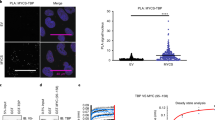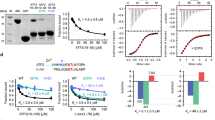Abstract
THE Jun proteins are nuclear proteins that combine with Fos proteins to form a gene-regulatory protein, AP-1. They have highly conserved DNA-binding and dimerization domains, resulting in almost identical sequence-recognition properties1–3. Nevertheless, there are many indications that each Jun protein activates a distinct and only partially overlapping set of AP-1 target genes4–6. Using the more variable activation domain of c-Jun as a bait, we identified a protein, JAB1, that interacts with c-Jun and JunD, but not with JunB or v-Jun. As a result, JAB1 selectively potentiates transactivation by only c-Jun or JunD. In vitro, JAB1 specifically stabilizes complexes of c-Jun or JunD with AP-1 sites and does not affect binding of either JunB or v-Jun. The amino-terminal half of JAB1 is very similar to the amino terminal region of Padl from fission yeast, which was identified genetically as a coactivator of a subset of AP-1 target genes7. JAB1 and Pad1 are also functionally interchangeable. They define a new group of coactivators that increase the specificity of target gene activation by AP-1 proteins.
This is a preview of subscription content, access via your institution
Access options
Subscribe to this journal
Receive 51 print issues and online access
$199.00 per year
only $3.90 per issue
Buy this article
- Purchase on Springer Link
- Instant access to full article PDF
Prices may be subject to local taxes which are calculated during checkout
Similar content being viewed by others
References
Angel, P. & Karin, M. Biochem. Biophys. Acta 1072, 129–157 (1991).
Nakabeppu, Y. & Nathans, D. EMBO J. 8, 3822–3841 (1989).
Risse, G. et al. EMBO J. 8, 3825–3832 (1989).
Hilberg, F., Aguzzi, A., Howells, N. & Wagner, E. F. Nature 365, 179–181 (1992).
Johnson, R. S., van Lingen, B., Papaioannou, V. E. & Spiegelman, B. M. Genes Dev. 7, 1309–1317 (1993).
Johnson, R. S., Spiegelman, B. M., Hanahan, D. & Wisdom, R. Mol. Cell. Biol. 16, 4504–4511 (1996).
Shimanuki, M., Saka, Y., Yanagida, M. & Toda, T. J. Cell Sci. 108, 569–579 (1995).
Fields, S. & Song, O. Nature 340, 245–246 (1989).
Durfee, T. et al. Genes Dev. 7, 555–569 (1993).
Smeal, T., Hibi, M. & Karin, M. EMBO J. 13, 6006–6010 (1994).
Angel, P. et al. Nature 332, 166–171 (1988).
Wilson, R. et al. Nature 368, 32–38 (1994).
Angel, P. et al. Cell 49, 729–739 (1987).
Arias, J. et al. Nature 370, 226–229 (1994).
Kumada, K., Yanagida, M. & Toda, T. Mol. Gen. Genet. 250, 59–68 (1995).
Toda, T., Shimanuki, M. & Yanagida, M. Genes Dev. 5, 60–73 (1991).
Chin, K.-V., Ueda, K., Tastan, I. & Gottesman, M. M. Science 255, 459–462 (1992).
Uchiumi, T. et al. FEBS Lett. 326, 11–16 (1993).
Hibi, M., Lin, A., Smeal, T., Minden, A. & Karin, M. Genes Dev. 7, 2135–2148 (1993).
van Dam, H. et al. EMBO J. 14, 1798–1811 (1995).
Chan, S. K., Jaffe, L., Capovilla, M., Botas, J. & Mann, R. S. Cell 78, 603–615 (1994).
van Dijk, M. A. & Murre, C. Cell 78, 617–624 (1994).
Bartel, P. L., Chien, C. T., Sternglanz, R. & Feilds, S. in Cellular Interactions in Developments: A Practical Approach (ed. Hartley, D. A.) 153–179 (Oxford Univ. Press, Oxford, 1993).
Angel, P., Smeal, T., Meek, J. & Karin, M. New Biol. 1, 35–43 (1989).
Guarente, L. Methods Enzymol. 101, 181–191 (1983).
Cavigelli, M., Dolfi, F., Claret, F. X. & Karin, M. EMBO J. 14, 5957–5964 (1995).
Claret, F. X., Antakly, T., Karin, M. & Saatcioglu, F. Mol. Cell. Biol. 16, 219–227 (1996).
Su, B. et al. Cell 77, 727–736 (1994).
Moreno, S., Klar, A. & Nurse, P. Methods Enzymol. 194, 795–823 (1991).
Ito, H., Fukuda, Y., Murata, K. & Kimura, A. J. Bacteriol. 153, 163–168 (1983).
Author information
Authors and Affiliations
Rights and permissions
About this article
Cite this article
Claret, FX., Hibi, M., Dhut, S. et al. A new group of conserved coactivators that increase the specificity of AP-1 transcription factors. Nature 383, 453–457 (1996). https://doi.org/10.1038/383453a0
Received:
Accepted:
Issue Date:
DOI: https://doi.org/10.1038/383453a0
This article is cited by
-
Regulatory mechanisms and therapeutic potential of JAB1 in neurological development and disorders
Molecular Medicine (2023)
-
Arabidopsis CSN5A Acts as a Transcriptional Co-activator of DREB2C During Seed Germination
Journal of Plant Biology (2023)
-
Prognostic value of CSN5 in patients with digestive system cancers: a systematic review and meta-analysis
BMC Cancer (2022)
-
Prognostic and therapeutic significance of COP9 signalosome subunit CSN5 in prostate cancer
Oncogene (2022)
-
Signaling of MK2 sustains robust AP1 activity for triple negative breast cancer tumorigenesis through direct phosphorylation of JAB1
npj Breast Cancer (2021)
Comments
By submitting a comment you agree to abide by our Terms and Community Guidelines. If you find something abusive or that does not comply with our terms or guidelines please flag it as inappropriate.



